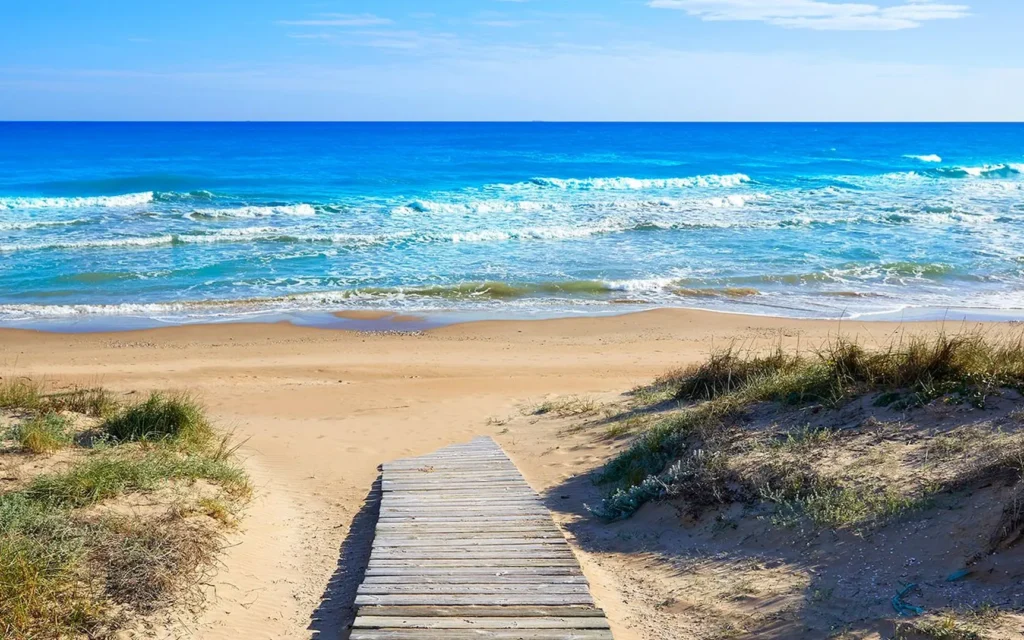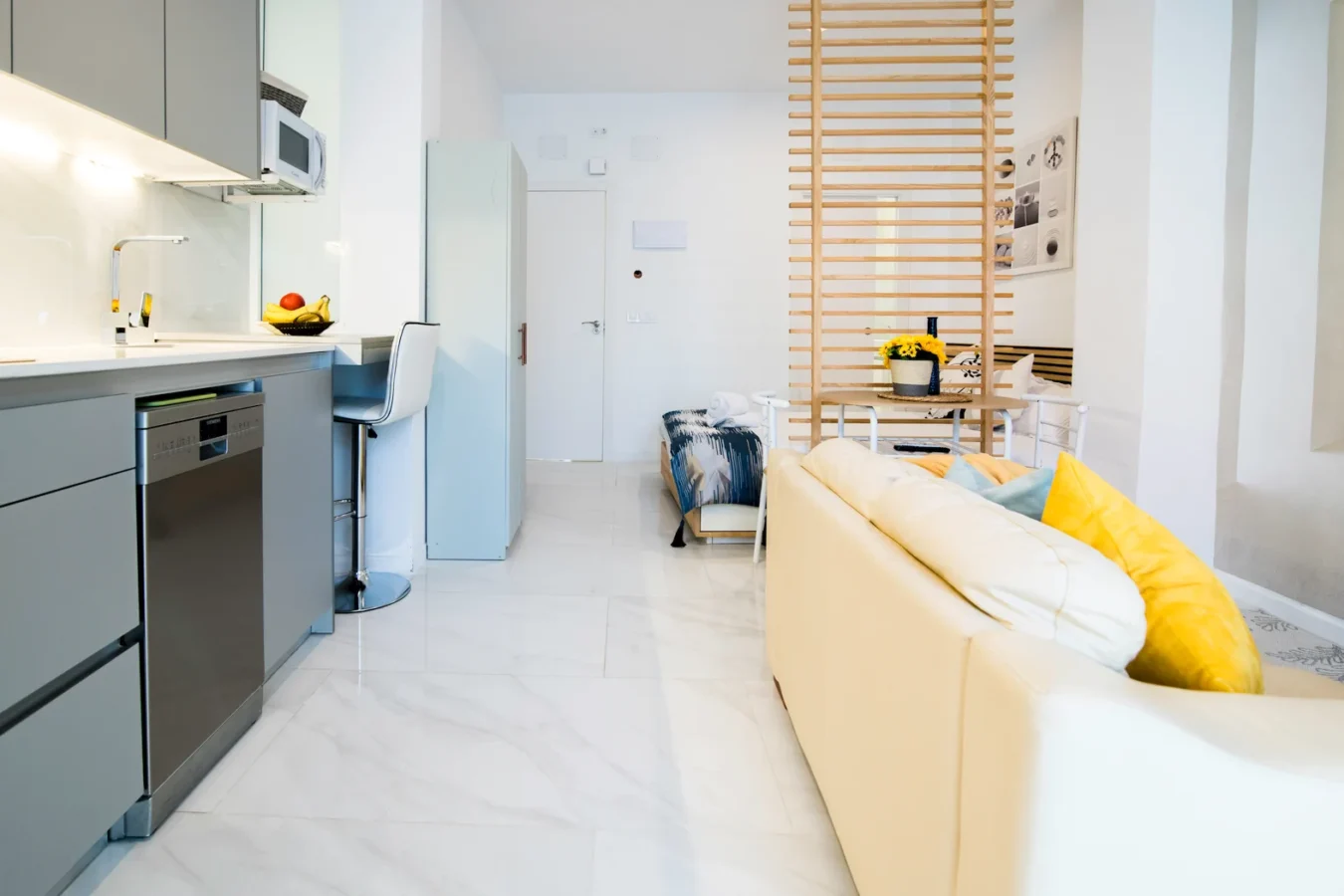Valencia offers visitors the perfect blend of city life and beach relaxation. Unlike many coastal cities where the best beaches require a car to reach, Valencia’s urban beaches (Patacona, Malvarrosa and Cabanyal) are easily accessible by public transport and provide everything a beach lover could want. If you’re planning a visit without a car, you’re in luck – some of the city’s most beautiful stretches of sand are just a short bus, tram or, our favorite, with a ValenbiSi rented bike.
Malvarrosa Beach: Valencia’s Iconic Shoreline
Malvarrosa is Valencia’s most famous beach, and for good reason. This wide stretch of golden sand extends for nearly a kilometer along the city’s eastern edge, offering plenty of space even during the busy summer months.
What Makes Malvarrosa Special
The beach features fine, golden sand that’s regularly maintained and cleaned. The gentle slope into the Mediterranean makes it perfect for swimmers of all levels, and the blue flag status indicates excellent water quality. The wide promenade (Paseo Marítimo) that runs alongside the beach is lined with palm trees, creating a quintessentially Mediterranean atmosphere.
Getting There Without a Car
Reaching Malvarrosa is simple using Valencia’s efficient public transport:
- By Tram: Take lines 4, 6, or 8 from the city center. The journey takes approximately 20-25 minutes.
- By Bus: Lines 1, 2, 19, 31, and 32 all serve Malvarrosa beach. The night bus (N1) also runs here if you’re enjoying a late evening by the sea.
- By Bicycle: Valencia is extremely bike-friendly, and the ride from the city center to Malvarrosa takes about 30 minutes along well-marked bike paths.
What to Do
Beyond sunbathing and swimming, Malvarrosa offers:
- Beach volleyball courts where locals and tourists mingle
- Water sports rentals for paddleboarding and kayaking
- The historic Balneario Las Arenas spa complex nearby
- Regular cultural events and festivals, especially during summer
Where to Eat
The promenade is famous for its restaurants serving authentic Valencian cuisine:
- Try the beachfront restaurants for paella with a sea view – La Pepica and Casa Carmela are historic establishments where even Hemingway once dined
- For more casual dining, the chiringuitos (beach bars) offer refreshing drinks and tapas
- Don’t miss horchata (a sweet tiger nut drink) at one of the local cafés
Cabanyal Beach (Las Arenas): Where History Meets the Sea
Just south of Malvarrosa lies Cabanyal Beach, also known as Las Arenas. While physically connected to Malvarrosa, this beach has its own distinct character, influenced by the historic fishermen’s quarter behind it.
What Makes Cabanyal Special
Cabanyal Beach tends to be slightly less crowded than Malvarrosa, making it perfect for those seeking a bit more tranquility. The beach is backed by the colorful and characterful Cabanyal neighborhood, one of Valencia’s most authentic areas with its distinctive tiled facades and narrow streets.
Getting There Without a Car
Cabanyal is served by the same public transport options as Malvarrosa:
- By Tram: Lines 4 and 6 to “Les Arenes” or “Eugenia Viñes” stops
- By Bus: Lines 2, 19, and 31 all have stops near Cabanyal beach
- By Train: Cabanyal train station is about a 15-minute walk from the beach
What to Do
Beyond the beach itself:
- Explore the Cabanyal neighborhood with its unique architecture and local atmosphere
- Visit the Marina Real Juan Carlos I and the America’s Cup Port
- Check out the local fish market if you’re there in the morning
- Enjoy the slightly more relaxed vibe compared to Malvarrosa
Where to Eat
The Cabanyal area offers some of the most authentic and affordable dining options:
- Casa Montaña, a historic tapas bar dating back to 1836
- La Lonja del Pescado for the freshest seafood
- The Mercabañal food market for a variety of local delicacies
Patacona Beach: The Relaxed Northern Extension
Continuing north from Malvarrosa, you’ll find Patacona Beach, technically in the neighboring municipality of Alboraya but seamlessly connected to Valencia’s beach strip.
What Makes Patacona Special
Patacona offers a more relaxed atmosphere than its southern neighbors. The beach is wide, the sand is fine, and the crowds are typically smaller. It’s popular with locals and families looking for a more laid-back beach experience.
Getting There Without a Car
Patacona is still easily accessible without a car:
- By Bus: Lines 31 and 32 run directly to Patacona
- By Tram: Take line 4 or 6 to the final stop and walk north (about 15 minutes)
- By Bicycle: The bike path extends all the way to Patacona, making for a scenic ride
What to Do
Patacona’s relaxed vibe is perfect for:
- Long beach walks along the less crowded shoreline
- More space for beach games and sports
- Watching spectacular sunsets with fewer people around
- Visiting the nearby horchata factories in Alboraya (the birthplace of this famous drink)
Where to Eat
Patacona has developed a reputation for trendy beach restaurants:
- La Más Bonita, a popular café with a beautiful terrace
- Brassa de Mar for excellent seafood
- Kima Beach for cocktails and Mediterranean cuisine
Tips for Beach-Going Without a Car
Valencia Tourist Card
Consider purchasing the Valencia Tourist Card, which offers unlimited public transport and discounts to many attractions. It’s available for 24, 48, or 72 hours.
Valenbisi Bike Sharing
Valencia’s bike-sharing system, Valenbisi, is perfect for beach trips. There are stations throughout the city and along the beach areas. A week-long subscription costs around €13.30 and gives you unlimited 30-minute rides.
Best Times to Visit
- Early Morning: For a peaceful experience and to secure a good spot (especially in summer)
- Late Afternoon: When many locals head home for dinner, creating more space
- Weekdays: Significantly less crowded than weekends, especially outside July-August
What to Bring
- Water and snacks (though there are plenty of shops nearby)
- Sun protection (the Valencia sun is strong, even in spring and fall)
- A small amount of cash for beach vendors and smaller establishments
- A travel towel that doesn’t collect sand
Year-Round Beach Enjoyment
While summer (June-September) is the obvious beach season, Valencia’s mild Mediterranean climate means you can enjoy the beaches almost year-round:
- Spring (April-May): Perfect for sunbathing with temperatures around 20-25°C, though the sea might still be cool
- Summer (June-September): Full beach season with hot temperatures and warm water
- Fall (October-November): Still warm enough for beach days with fewer crowds
- Winter (December-March): While swimming might be for the brave, the beaches are perfect for walks and enjoying seafront restaurants
Connecting Beach Areas to City Attractions
One of Valencia’s greatest charms is how easily you can combine beach time with cultural experiences:
- Spend the morning at the futuristic City of Arts and Sciences, then head to the beach for the afternoon
- Visit the historic Old Town in the morning, then cool off at Malvarrosa later
- Explore the Turia Gardens (the converted riverbed park) by bike on your way to the beach
Conclusion
Valencia’s urban beaches offer the perfect solution for travelers without a car. With excellent public transport connections, you can easily enjoy the Mediterranean sun, sand, and sea while still being close to all the cultural attractions the city has to offer. Whether you prefer the lively atmosphere of Malvarrosa, the local charm of Cabanyal, or the relaxed vibe of Patacona, Valencia’s beaches provide a seaside experience that rivals any coastal destination – no car required.
So pack your swimsuit, grab your sunscreen, and hop on a bus or tram to experience the best of Valencia’s urban beach life. The perfect combination of city exploration and beach relaxation awaits!


